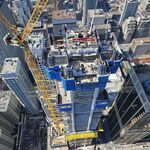Tuck
Active Member
UnrealAs of March '23, the budget for this station was 234M.........and climbing.
And........ No that isn't at all justified.
UnrealAs of March '23, the budget for this station was 234M.........and climbing.
And........ No that isn't at all justified.
I would love to see a bill of materials for the typical ML GO station - how many cubic meters of concrete, how many tons of steel, how many meters of conduit, how many (kilo)meters of cabling. Compare that to the gold standard of regional rail stations. I bet those other operators don't overbuild.
There are a few amenities that we need to add - snow melt platforms make good sense, for instance - but nobody gets frostbite while waiting for service on 15 minute headways. Our stations do not need to be hurricane proof.
- Paul
Didnt realize it was that bad. Yikes.I saw an interesting graphic on @thetransitguy's Instagram page comparing capital costs for Metrolinx's transit projects versus those in Italy. For those who can't see the graphic, it indicates that Metrolinx spends 17.9% of the typical project cost on stations versus 27.2% in Italy. Guess who tends to have better stations, Metrolinx or Italy? It's not an unfair comparison either, since Metrolinx runs the country's busiest transit hub, builds urban rapid transit, and builds regional transit stations--basically a smattering of everything.
According to the graphic, Metrolinx spends 55.8% of the budget on "soft costs", including professional services (e.g. engineers, consultants, and lawyers), contingency, escalation, property acquisition, and taxes. "Soft costs" only account for 23.9% of transit expansion project spending in Italy. The difference is stark, which inevitably gets made up with the quality of stations.
@thetransitguy's idea seems to be is that maintaining an experienced in-house design, engineering, and project management team is more cost effective in the long run for transit expansion because the team builds on its experience and passes it down from generation to generation. This approach potentially allows for more money to be spent on stations. Metrolinx could use this approach, as its projects are very expensive for stations that too often look like parking garages on the inside.
well at least we know the main culprit behind the out of control capital costs. Considering how much Conservatives rail about "government waste" you'd think getting Metrolinx project costs under control would be priority #1.The graphic linked to by @junctionist above is a good one.
Its been posted here before, but no harm in adding it here.
Let me bring it forward:
Any project that I have bid on, drawings were 100% done at the time of the tender. Have said that, we have seen changes take place after work has started caused by various things and it doesn't happen on every projects. Some are design flaws, change in type of equipment to be used on the site, a better way to do things that trades have come up that will save time and money at the end.well at least we know the main culprit behind the out of control capital costs. Considering how much Conservatives rail about "government waste" you'd think getting Metrolinx project costs under control would be priority #1.
Going forward projects shouldn't go to tender until most of the design work is completed. Unfortunately that doesn't go well with the 4 year political cycles and politicians rushing to make to announcements and cut ribbons.




